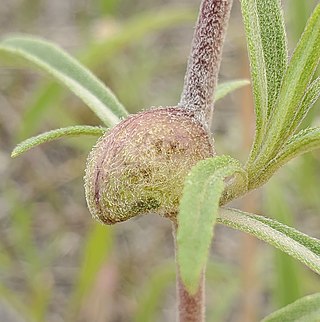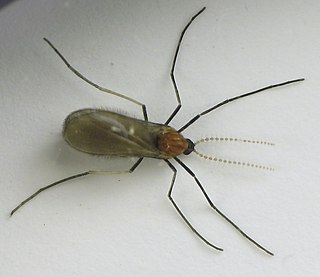
Cecidomyiidae is a family of flies known as gall midges or gall gnats. As the name implies, the larvae of most gall midges feed within plant tissue, creating abnormal plant growths called galls. Cecidomyiidae are very fragile small insects usually only 2–3 mm (0.079–0.118 in) in length; many are less than 1 mm (0.039 in) long. They are characterised by hairy wings, unusual in the order Diptera, and have long antennae. Some Cecidomyiids are also known for the strange phenomenon of paedogenesis in which the larval stage reproduces without maturing first. In some species, the daughter larvae consume the mother, while in others, reproduction occurs later on in the egg or pupa.

The goldenrod gall fly, also known as the goldenrod ball gallmaker, is a species of fly native to North America. The species is best known for the characteristic galls it forms on several species in the Solidago, or goldenrod, genus. The fly's eggs are inserted near the developing buds of the plant. After hatching, the larvae migrate to an area below the plant's developing buds, where they then induce the plant's tissues to form into the hardened, bulbous chamber referred to as a gall. E. solidaginis’s interactions with its host plant(s) and insect, as well as avian, predators have made it the centerpiece of much ecological and evolutionary biology research, and its tolerance of freezing temperatures has inspired studies into the anti-freeze properties of its biochemistry.

Asphondylia is a cosmopolitan genus of gall midges in the family Cecidomyiidae. All species in this genus induce galls on plants, especially on flowers and flower buds. There are over 300 described species in Asphondylia, with many more likely to be discovered and described, especially in the southern hemisphere.

Rhopalomyia is a genus of gall midges, insects in the family Cecidomyiidae. There are at least 267 described species in Rhopalomyia. Most species in this genus induce galls on plants in the Asteraceae. This genus has a cosmopolitan distribution. Rhopalomyia was first established by Ewald Heinrich Rübsaamen in 1892.

Rhopalomyia anthophilathe Downy Flower Gall Midgeis a species of gall midges, insects in the family Cecidomyiidae. It induces galls on the host Solidago altissima across much of North America.
Asphondylia betheli is a species of gall midge in the family Cecidomyiidae. This midge is widespread in the southwestern United States. The larvae of this species induce galls on in the fruit of Opuntia cacti.

Asphondylia helianthiglobulus is a species of gall midge in the family Cecidomyiidae. The larvae of this species induce galls on the stems of several sunflower species in eastern North America, including Helianthus giganteus,H. grosseserratus, and H. maximiliani.

Asphondylia rudbeckiaeconspicua is a species of gall midges in the family Cecidomyiidae. The larvae induce galls on Rudbeckia laciniata in North America. It was first described by Carl Robert Osten-Sacken in 1878.

Rhopalomyia solidaginis, the goldenrod bunch gall, is a species of gall midges, insects in the family Cecidomyiidae The galls of this species have the following host species of goldenrods:Solidago altissima, Solidago canadensis, Solidago rugosa They have been found across eastern North American.

Ampelomyia vitiscoryloides, the grape filbert gall midge, is a species of gall midge in the family Cecidomyiidae. It induces galls on grape plants and is widespread in eastern North America. It was first described by Alpheus Spring Packard in 1869.

Asphondylia floccosa, the woolly stem gall midge, is a species of gall midges in the family Cecidomyiidae. The larvae induce galls on Atriplex polycarpa. They don't feed on the gall itself, but rather fungus that grows within the gall. Each gall can contain anywhere from one to fifteen chambers. This species is known from Arizona and California, and was first described by American entomologist Raymond Gagne in 1968.

Schizomyia racemicola is a species of fly in the family Cecidomyiidae. This gall midge species induces galls on goldenrods in eastern North America. It was first described by Carl Robert Osten-Sacken in 1862.

Asphondylia solidaginis is a species of gall midge (Cecidomyiidae) that induces galls on goldenrods in North America where it is widespread. It was first described by William Beutenmuller in 1907.

Olpodiplosis is a monotypic genus of gall midges, insects in the family Cecidomyiidae. The only described species is Olpodiplosis helianthi.

Asteromyia carbonifera is a species of gall midges in the family Cecidomyiidae. It creates galls on Solidago plants. Females can lay up to 300 eggs at a time and often collect conidia of the fungus Botryosphaeria dothidea, which is deposited on the plant alongside the eggs. The larvae grow within the gall that the fungus creates, a form of mutualism.

Rhopalomyia clarkei is a species of gall midges, insects in the family Cecidomyiidae. The larvae induce galls on two hosts: Solidago altissima and Solidago rugosa and are found in north-eastern and north central North America.
Asphondylia amaranthi is a species of gall midge in the family Cecidomyiidae.
Asphondylia antennariae is a species of gall midge in the family Cecidomyiidae. The larvae of this species induce galls on the buds of Antennaria plantaginifolia. This species is known from Wisconsin and Maine in the United States, though it's host plant is widespread in eastern North America. It was first described by American entomologist William Morton Wheeler in 1889.
Asphondylia artemisiae is a species of gall midge in the family Cecidomyiidae. The larvae of this species induce galls on at least one species of sagebrush Artemisia (plant). This species is only known from Arizona in the United States. It was first described by American entomologist Ephraim Porter Felt in 1908.
Anodontoceras is a genus of wood midges in the family Cecidomyiidae. There are three described species. The genus was established by Japanese entomologist Junichi Yukawa in 1967.















